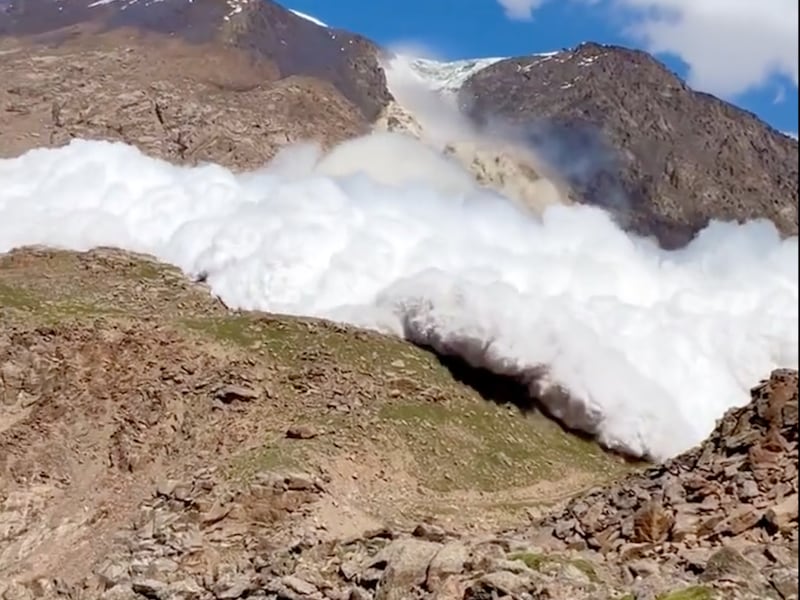Terrifying video surfaced over the weekend of a glacier collapsing in the Tian Shan mountains of Kyrgyzstan, triggering a massive avalanche that nearly buried 10 hikers on a guided tour.
The tense moment comes about a week after a glacier collapsed in the Italian alps, killing 11.
Scientists say warming temperatures, including a prolonged heat wave in Italy, are behind both incidents.
‘It was like being inside a blizzard’
Footage posted on Instagram by Harry Shimmin, reportedly one of the 10 nearly buried hikers, shows a massive wall of snow and ice barreling toward the group. Shimmin films the wall of debris until it’s literally on top of him, ducking behind a large boulder at the last second.
“While I was taking pictures I heard the sound of deep ice cracking behind me,” Shimmin wrote on Instagram. “This is where the video starts. I’d been there for a few minutes already so I knew there was a spot for shelter right next to me. I was on a cliff edge, so I could only run away from the shelter.”
It became dark and difficult to breathe as the cloud of snow enveloped Shimmin, who said that’s when we thought he might die.

“It was like being inside a blizzard. Once it was over the adrenaline rush hit me hard. I was only covered in a small layer of snow, without a scratch. I felt giddy,” he said.
Shimmin then walked down the mountain to check on his group. He said one woman required medical attention for a cut on her knee.
“The whole group was laughing and crying, happy to be alive ... It was only later we realized just how lucky we’d been. If we had walked 5 minutes further on our trek, we would all be dead,” he wrote.
“The path runs alongside a low ridge, hiding the mountain from view, so we would have only heard the roar before lights out.”
Climate change behind deadly glacier collapse in Italy, scientists say
Italy is coping with a heat wave that drove temperatures up to a record-breaking 105 degrees in Rome, 100 in Naples and 107 in Tuscany this past June.
Those temperatures contributed to the deterioration of the Marmolada mountain group in Italy’s Dolomite range, where on July 3 part of a glacier collapsed and sent a wall of snow, ice and rocks charging down a popular summer alpine route.
Officials later discovered the remains of 11 mountaineers killed in the avalanche.
Just days before, the Mamolada had experienced record temperatures, according to a spokesman for Italy’s National Alpine and Speleological Rescue Corps, who told The New York Times it was the biggest accident on the mountain in decades.
Though thousands of miles apart, the incidents in Kyrgyzstan and Italy are remarkably similar, and have one thing in common — climate change. Scientists told The Guardian that events like this will become more common as the world deals with abnormal weather events and record high temperatures.
Italian Prime Minister Mario Draghi said the tragedy was a result of the “deterioration of the environment and the climate situation,” while the country’s president, Sergio Mattarella, called it a “symbol of what climate change, if not governed, is producing around the world,” according to The New York Times.
The Tian Shan mountains in southeastern Kyrgyzstan along the Chinese border have long been a destination for hikers and mountaineers.
However the country’s president, Sadyr Zhaparov, says Kyrgyzstan’s mountain regions are reeling from climate change.
“Kyrgyzstan is home for almost 10,000 glaciers. Over the last 20 years, we are witnessing an irreversible melting of those century-old glaciers,” Zhaparov told the Independent just weeks before Shimmin’s video of the avalanche went viral.
“The world is facing global climate change, which is fraught with dangerous consequences,” said Zhaparov. “This is especially true for us mountain countries because these problems are more dynamic and specific: glaciers melting and natural water reserves decreasing, which can lead to imminent disaster.

